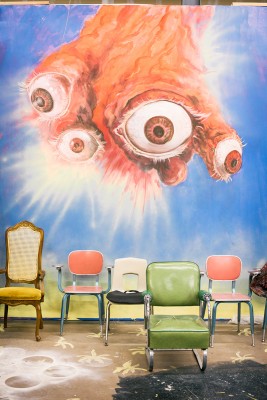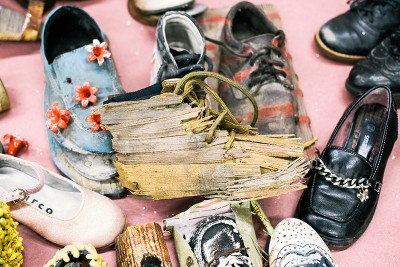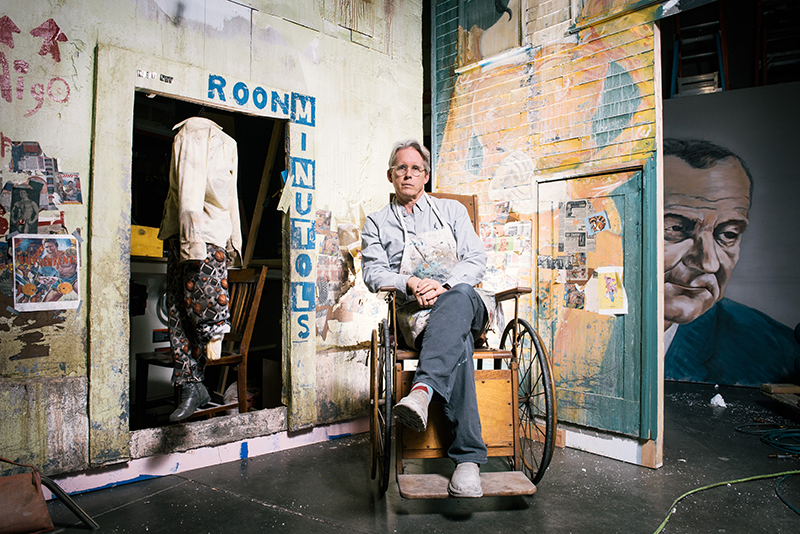Sisyphean Art: David Brothers’ Rolithica
Art
David Brothers had always been a fan of Southern Gothic literature. “I loved Flannery O’Connor and the rants of Baptist preachers,” he says. Riffing off of the conventions of fundamentalist Christianity and fringe cults of the day, Brothers, at only 20, created an absurd quasi-entity called The Church of Jayne Mansfield, and regularly aired inflammatory broadcasts on a Christian radio station. The station’s regular listeners soon began calling in to voice their outrage. “It spun out of control,” he says. It caught the attention of the national media, and in short time, Brothers found himself receiving queries from Rolling Stone magazine. Others might seize the moment to gain celebrity status, but Brothers chose otherwise. “It was a piece of performance art,” he says, “but I felt it had become too fake, easy. I shut it down.”
In his current art practice, David Brothers builds and photographs without any official assistant. “I’ve learned to work fast,” he says. “I know in advance what I need for a shoot, so there’s no tendency to overbuild.” Nevertheless, these sets are highly labor-intensive, taking some two to three hundred hours to complete. “Sometimes I feel like Sisyphus,” he says, “always building, only to tear back down—though I have learned to find satisfaction in futility.”

David Brothers describes himself as someone who needs a constant challenge. “I learned to be persistent mostly by observing the intense motivation of others. I guess I need a battle, though deadlines certainly help.” Brothers’ preferred form of battle is not a quest for victory so much as a mere struggle for survival. “I come from a post-hippie, non-yuppie background,” he says. “For us, to be ambitious was uncool.” Consequently, when asked about how it feels now to suddenly receive the artistic recognition he has for so long lacked, the voluble artist suddenly grows pensive.
David Brothers tells me he grew up as the junior member of a community of Utah artists, most of them based in Davis County. These were all very gifted, driven, generous and inspiring persons, Brothers says, “but each seemed to have some fatal flaw, the kind of thing that wrecks a career but makes for a great novel.” As opposed to advancing a career, Brothers claims simply to have immersed himself in his present work. “When I consider that I’ve remained a motivated and active artist for so many years, I feel I’ve had success all along.”
To survive financially, David Brothers has worked as a “key scenic” (managing a crew of four to 12 set painters) for a variety of well-known projects, including Disney films such as High School Musical. “I’ve always loved my job,” he says. “I love to paint.” Brothers’ life as a painter initially began in the Studio Art and Film programs at the University of Utah. “But I felt I arrived a year or two too late,” he says. “I would hear stories of how wildly creative the environment used to be, about visits by major troublemakers like Chris Burden and Andy Warhol. But all that went away. I remember being told by one of the remaining older teachers that art school had become a place artists go to die.” Brothers tried to maintain a free and provocative spirit nevertheless, and he always chose the more difficult path. “Filmmaking back in those pre-digital days, it was so complicated and expensive,” he says. “You’d have had to be insane to go into it.” Indeed, Brothers considers much of the most interesting art from that time to have been decidedly low-tech. “I remember the beginnings of zine culture, or feeling the need to inspect every telephone pole in the city to know what was going on.”

Aside from DIY graphic culture, David Brothers also drew inspiration from various venerable institutions around Salt Lake. “I really liked the old Natural History Museum on the [University of Utah] campus,” he says. “It still had a Smithsonian mystique to it. And I remember the feeling of entering the old Hansen Planetarium. These places awakened my sense of time and memory.” To step into these buildings was to be transported, like Fredric Jameson stepping into the Weston Bonaventure, into a fantastic, alternative world. For Brothers, their disappearance is a genuine cultural loss. “When I was much younger, I didn’t think much of it, but now, when I see an old building being torn down, I get really pissed.” Our current consume/dispose/move-on society is far too transitory for Brothers. “Nobody stays put anymore,” he says. Nor, he believes, does anybody respect the slow personalizing process of dilapidation, the time it takes to break things in.
In contrast, David Brothers has created Rolithica, an imaginary world in which Brothers can abide. “There is no script and there are no identifiable characters,” he says, though there is an implicit set of rules which—right down to the artificial language Brothers invented for his world—determine Rolithica’s evolving shape, of which Brothers’ photos grant us fragmentary glimpses. All of this lends Rolithica a sense of what Brothers calls “divinity,” which, in my view, could mean the possibility of creating a private world on his own unique terms, one with some residual sense of mystery, of “aura.” By this, Brothers seems to maintain a sense of self-sufficiency and the freedom to create a world of objects that exist for their own sake, still building churches after all these years—hence Brothers’ imperative to decorate.
David Brothers’ Rolithica opened Jan. 29 and runs through April 30 at the Utah Museum of Contemporary Art. An opening reception will be held on Feb. 5 at 7 p.m. The exhibition and reception are free and open to the public.
